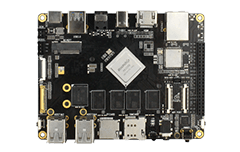4. Customized Android firmware¶
4.1. preface¶
Note: The following is only compatible with Android 8.1 and below.
There are two ways to customize Android firmware:
Change the source code and compile the firmware.
Tailoring the existing firmware.
In the former method, Android can be customized from all levels, with great freedom, but high requirements for the compilation environment and technology, which can be referred to [Compile Android firmware].(compile_android8.1_firmware.html). Now introduce the latter method, which is divided into three phases: unpacking, customization and packaging. The host operating system is Linux, and the tools used are open source software.
4.2. Firmware format¶
Unified firmware release_update.img contains the boot loader loader.img and the actual firmware data - update.img.
release_update.img
|- loader.img
`- update.img
update.img is a composite file containing multiple files described by package-file. A typical package-file is:
# NAME Relative path package-file package-file bootloader Image/MiniLoaderAll.bin parameter
Image/parameter.txt trust
Image/trust.img uboot
Image/uboot.img misc
Image/misc.img resource
Image/resource.img kernel
Image/kernel.img boot
Image/boot.img recovery
Image/recovery.img system
Image/system.img backup RESERVED
#update-script update-script #recover-script recover-script
package-file
update.imgpackage description file,update.imgalso contains apackage-file.
Image/MiniLoaderAll.bin
Start the loader - bootloader.
Image/parameter.txt
Parameter file, can set the kernel boot parameters, there are important partition information.
Image/trust.img
trust.imgis the U-Boot as the secondary loader package.
Image/misc.img
Image of misc partition, used to control whether Android starts normally or enters Recovery Mode.
Image/kernel.img
Android kernel.
Image/resource.img
Resource image with kernel boot image and kernel Device Tree Blob.
Image/boot.img
The memory boot disk (initrd) of the Android kernel, the first root file system to be loaded after the kernel is started, contains important initialization actions that generally do not need to be changed.
Image/recovery.img
Android image,including Recovery Mode with kernel and root file system of Recovery Mode.
Image/system.img
Corresponds to the Android
/systempartition and is the following custom object.
Unpacking, is to extract the update.img from release_update.img, then the extracted with package-file statement by multiple files.
Packaging is an inverse process to synthesize the multiple files listed in the package-file to update.img, add to the loader.img, and finally generate the release_update.img.
4.3. Tools preparation¶
git clone https://github.com/TeeFirefly/rk2918_tools.git
cd rk2918_tools
make
sudo cp afptool img_unpack img_maker mkkrnlimg /usr/local/bin
4.4. Unpack¶
Extract the
release_update.img
$ cd /path/to/your/firmware/dir
$ img_unpack Firefly-RK3399_20161027.img img
rom version: 6.0.1
build time: 2016-10-27 14:58:18
chip: 33333043
checking md5sum....OK
Extract the
update.img
$ cd img
$ afptool -unpack update.img update
Check file...OK
------- UNPACK -------
package-file 0x00000800 0x00000280
Image/MiniLoaderAll.bin 0x00001000 0x0003E94E
Image/parameter.txt 0x00040000 0x00000350
Image/trust.img 0x00040800 0x00400000
Image/uboot.img 0x00440800 0x00400000
Image/misc.img 0x00840800 0x0000C000
Image/resource.img 0x0084C800 0x0003FE00
Image/kernel.img 0x0088C800 0x00F5D00C
Image/boot.img 0x017EA000 0x0014AD24
Image/recovery.img 0x01935000 0x013C0000
Image/system.img 0x02CF5000 0x2622A000
RESERVED 0x00000000 0x00000000
UnPack OK!
View the file tree under the update directory
$ cd update/
$ tree
.
├── Image
│ ├── boot.img
│ ├── kernel.img
│ ├── MiniLoaderAll.bin
│ ├── misc.img
│ ├── parameter.txt
│ ├── recovery.img
│ ├── resource.img
│ ├── system.img
│ ├── trust.img
│ └── uboot.img
├── package-file
└── RESERVED
1 directory, 12 files
Now that the firmware has been unpacked successfully, let’s start customizing it.
4.5. Customize¶
4.5.1. Customize the system.img¶
System.img is an ext4 file format image file that can be mounted directly to the system for modification:
sudo mkdir -p /mnt/system
sudo mount -o loop Image/system.img /mnt/system
cd /mnt/system
# Notice how much space is left when modify inside,and don't add too much APK.
# After modification, uninstall.
cd /
sudo umount /mnt/system
Note: The remaining space of the system.img is basically 0. If the file is not deleted, the capacity of system.img needs to be expanded, and the partition Settings in the parameter file are adjusted accordingly according to the final file size. The following is an example of how to extend the space. Before extending, run mount to see how the system is mounted and ensure that system.img has been unmounted:
# Increase the space by 128M
dd if=/dev/zero bs=1M count=128 >> Image/system.img
# Extend file system information
e2fsck -f Image/system.img
resize2fs Image/system.img
4.5.2. Pack¶
First, check the size of system.img and make necessary size adjustments against the partition of the parameter file.(Refer to the documentation The file format parameter)
For example, the system partition size in parameter.txt file, you can find the CMDLINE line and then find the system string:
0x00200000@0x000B0000(system)
Before @ is the size of the partition, the unit is 512 bytes, so the size of the system partition is:
$ echo $(( 0x00200000 * 512 / 1024 / 1024))M
1024M
As long as the size of system.img does not exceed 1024M, the parameter file does not need to be changed.
If the partition does not change, you can use the upgrade tool to upgrade the new system.img directly to the system partition on the development board for testing. Otherwise, you need to make new firmware and burn it before testing.
Here are the steps required to package it into a unified firmware update.img:
Compose update.img:
# The current directory is still update/, with package-file and all files listed in package-file.
# Copy the parameter file to paramter, because it is used by default by afptool.
$ cp Image/parameter.txt parameter
$ afptool -pack . ../update_new.img
------ PACKAGE ------
Add file: ./package-file
Add file: ./Image/MiniLoaderAll.bin
Add file: ./Image/parameter.txt
Add file: ./Image/trust.img
Add file: ./Image/uboot.img
Add file: ./Image/misc.img
Add file: ./Image/resource.img
Add file: ./Image/kernel.img
Add file: ./Image/boot.img
Add file: ./Image/recovery.img
Add file: ./Image/system.img
Add file: ./RESERVED
Add CRC...
------ OK ------
Pack OK!
Compose release_update.img :
$ img_maker -rk33 loader.img update_new.img release_update_new.img
generate image...
append md5sum...
success!
release_update_new.img is a unified firmware file that can be upgraded for the final generation
4.6. FAQS¶
Q1 : Where’s the firmware version Settings?
A1 : In the parameter file, you can find the downward direction and modify it. Note that the version number is a number, and the middle two dots cannot be omitted.
AND_FW_VER: 6.0.1
